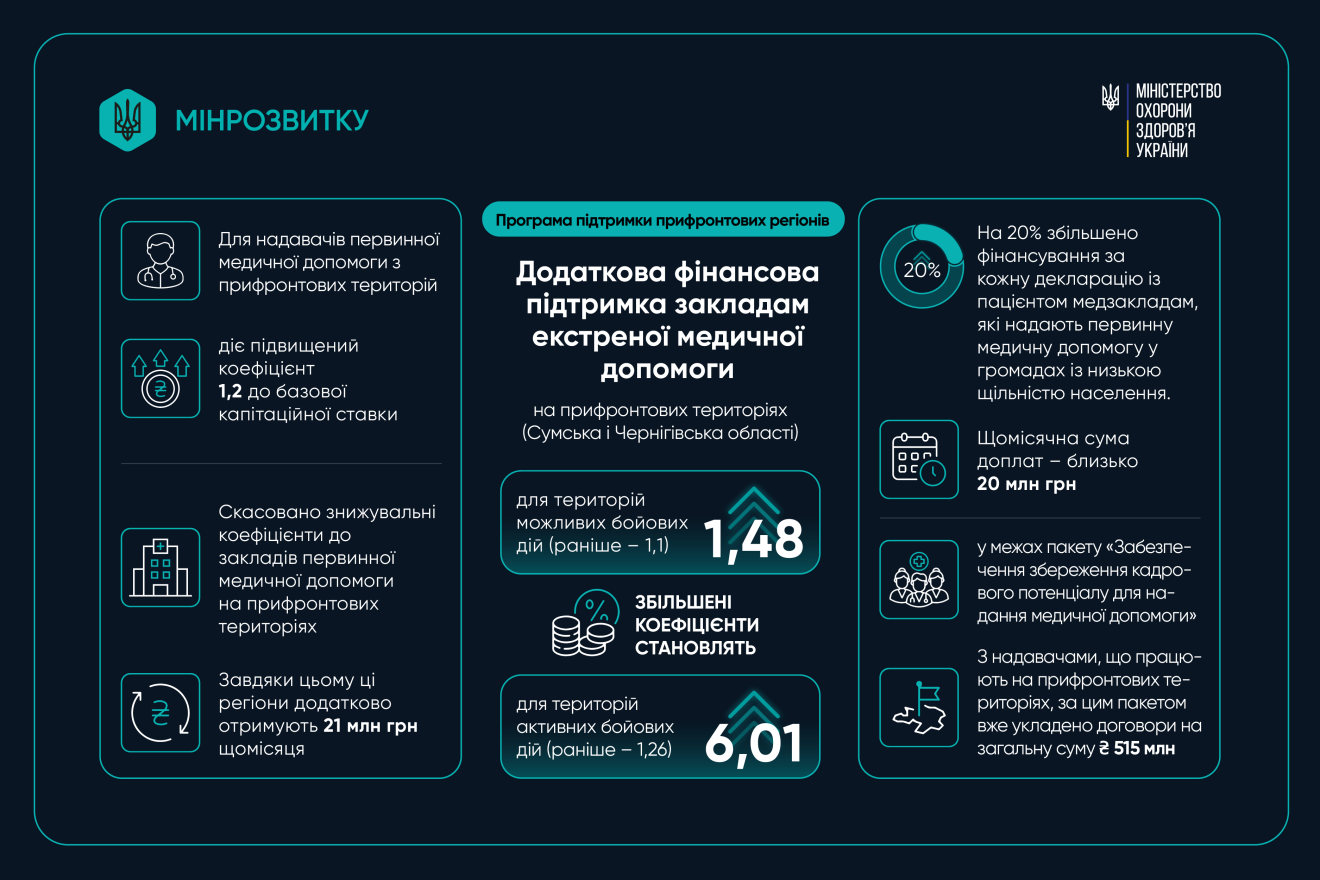In order for Ukrainians from frontline areas to have proper living conditions and unhindered access to quality services – educational, social, medical – the Government has introduced a Comprehensive Program to Support Frontline Regions.
Within the framework of this program, from August to November 2025, medical institutions operating in frontline, remote communities and those where active hostilities are underway have already received over UAH 280 million in additional funding. The funds are aimed at improving people’s access to medical care, as well as providing support to medical workers.
In total, medical institutions have received an additional UAH 282 million:
UAH 54.2 million — additional payments to primary medical care institutions;
UAH 56.2 million — additional payments to emergency medical care institutions;
UAH 171.7 million — funding under the package “Ensuring the preservation of human resources for the provision of medical care”.
“Frontline communities live in difficult conditions of constant shelling. The state’s task is to provide people with equally high-quality and accessible social services, including medical services, even in areas of increased risk. And also to support those who, in close proximity to the front, continue to work in the field of healthcare and save human lives. The changes introduced within the framework of the Frontline Regions Support Program provide the opportunity for additional financing of medical institutions, which allows increasing salaries and preserving professional human resources,” noted Oleksiy Kuleba, Deputy Prime Minister for the Reconstruction of Ukraine – Minister of Development of Communities and Territories of Ukraine.

Since October of this year, primary care providers working in frontline areas (currently nine such areas have been identified) have been subject to an increased coefficient of 1.2 to the basic capitation rate.
In October, the total amount of additional payments for these areas — Dnipropetrovsk, Donetsk, Zaporizhia, Mykolaiv, Odessa, Sumy, Kharkiv, Kherson, Chernihiv — amounted to UAH 5.8 million.
The following regions received the largest amounts of additional payments under the coefficient of 1.2:
Kherson region — UAH 2.2 million each month;
Dnipropetrovsk region — UAH 1.6 million;
Donetsk region — UAH 1.1 million each.
In addition, the discount coefficients for primary care facilities in frontline areas have been canceled, thanks to which payments have been increased by another UAH 21 million each month.
Due to the absence of adjustment coefficients, the largest increase in funding was in Kharkiv region (+7.6 million UAH per month), Zaporizhia region (+3.2 million UAH) and Odesa region (+3.1 million UAH).
Additionally, financial support is provided to emergency medical care facilities in frontline areas (Sumy and Chernihiv regions)
The new increased coefficients are now:
1.48 – for areas of possible hostilities (previously 1.1);
6.01 – for areas of active hostilities (previously 1.26).
Also, 20% more funding for each declaration with a patient is already being received by facilities that provide primary medical care in communities with low population density.
Starting from September, the monthly amount of such additional payments is about 20 million UAH.
The “Ensuring the Preservation of Human Resources for the Provision of Medical Care” package provides additional funding for medical facilities operating in combat zones.
Such facilities will receive a certain amount per employee each month to increase their payroll. Since the beginning of the changes, contracts for a total of UAH 515 million have already been signed with providers operating in frontline areas under the “Ensuring the Preservation of Human Resources for the Provision of Medical Care” package.
For reference: The Frontline Areas Support Program is a comprehensive 10-year program that combines the reconstruction of housing, schools, hospitals, and critical infrastructure with support for local businesses and direct assistance to people. The program is based on five priorities: people, housing, security, business, and health. This provides communities not only with restored infrastructure, but also with resources for long-term development, even in difficult conditions caused by the war.

